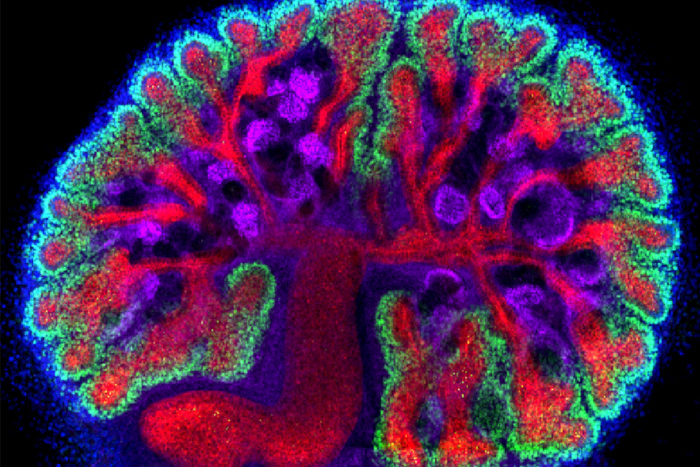Mouse study shows potential of gene therapy for Alport syndrome
New research in mice suggests that gene therapy may be a viable treatment for Alport syndrome, an inherited disease that leads to kidney failure

Stained cultured mouse kidney.
Alport syndrome is caused by mutations in one of three genes that collectively produce a special type of collagen, a critical component of the basement membrane that lines blood vessels in the kidneys. Disruption in any one of these genes alters the collagen network, leaving the basement membrane with defects that make it unable to adequately filter wastes from the blood into urine. The syndrome affects one in 5,000 people and is more common among men than women.
Strictly controlling blood pressure can slow progression of the syndrome but most patients develop end-stage kidney disease by the time they reach adolescence or young adulthood. At that point, the standard treatment is dialysis, with the goal of an eventual kidney transplant. But many patients die on the waiting list because a match is not available.
Gene therapy in mice prolongs life
In a new study Jeffrey Miner, PhD, Washington University renal disease researcher, shows that gene-based therapy in mice with Alport syndrome can restore the missing collagen network, slow progression of kidney disease and extend life span.
As part of the research, Miner and his colleagues demonstrated they could induce expression of a missing collagen gene at 21 days, when mice are similar in age to human preadolescents. When activated, the gene produced enough collagen to repair the basement membrane, although some irregularities persisted.
Without the therapy, Alport mice survived no longer than 32 weeks, compared with treated mice, which typically lived twice as long. Several survived for well over a year, clearly benefiting from the therapy.
“Even with treatment, there were some abnormalities in the basement membrane and in kidney function,” Miner said. “But the damage was not significant enough to cause end-stage kidney disease. If the same treatment were successfully translated to patients, it could postpone the need for dialysis and buy patients more time to find the right kidney donor, and that’s important.”







